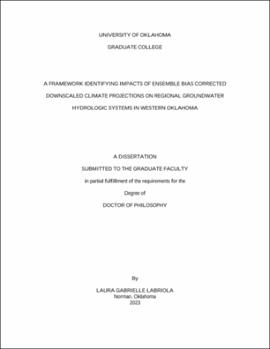| dc.contributor.advisor | Hong, Yang | |
| dc.contributor.author | Labriola, Laura | |
| dc.date.accessioned | 2023-12-19T20:35:14Z | |
| dc.date.available | 2023-12-19T20:35:14Z | |
| dc.date.issued | 2023-12-15 | |
| dc.identifier.uri | https://hdl.handle.net/11244/340071 | |
| dc.description.abstract | Groundwater is an important natural resource that is highly sensitive to both precipitation and temperature, factors climate models project will change in the future. General circulation models (GCM) are available to forecast future climatic conditions and subsequently, can be used as forcings to simulate the impact of climate change on water resources. Water resource managers utilize estimations and outlooks of future groundwater availability to assist in long-term planning; however, most of these do not include inputs from climate models.
The purpose of this work is to develop a framework for using climate model data from GCMs in numerical groundwater models to understand the effects of projected climates and estimate outlooks of groundwater availability on a localized scale. This dissertation incorporates climate projections coupled with numerical groundwater models to produce outlooks for a range of future groundwater availability scenarios in western Oklahoma, including in the North Fork Red River aquifer and the reach 1 of the Washita River alluvial aquifer. The framework begins with climate-model datasets, including precipitation and temperature, from 231 Coupled Model Intercomparison Project phase 5 (CMIP5) projections. Each of the climate projections were bias corrected, downscaled, numerically adjusted to represent the climate change trend, and prepared to be used in hydrologic models. The downscaled climate-adjusted datasets are used as input into hydrologic models, which simulate recharge, evapotranspiration, and groundwater storage variables. The first two case studies verified the applicability of the framework. The third case study proposes a novel framework that included uncertainty and extremes by analyzing the simulated hydrologic variables with a probabilistic approach. The outcomes from this research emphasize the importance of incorporating projected climate-model data into hydrologic models to assess future water resource conditions. | en_US |
| dc.language | en_US | en_US |
| dc.rights | Attribution 4.0 International | * |
| dc.rights.uri | https://creativecommons.org/licenses/by/4.0/ | * |
| dc.subject | groundwater modeling | en_US |
| dc.subject | downscaled climate projections | en_US |
| dc.subject | groundwater resources | en_US |
| dc.title | A Framework Identifying Impacts of Ensemble Bias Corrected Downscaled Climate Projections on Regional Groundwater Hydrologic Systems in Western Oklahoma | en_US |
| dc.contributor.committeeMember | Palmer, Robert | |
| dc.contributor.committeeMember | Kolar, Randall | |
| dc.contributor.committeeMember | Sabatini, David | |
| dc.contributor.committeeMember | Kirstetter, Pierre-Emmanuel | |
| dc.date.manuscript | 2023-12 | |
| dc.thesis.degree | Ph.D. | en_US |
| ou.group | Gallogly College of Engineering::School of Civil Engineering and Environmental Science | en_US |
| shareok.nativefileaccess | restricted | en_US |

